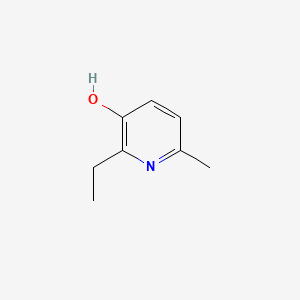








1. 2-ethyl-6-methyl-3-hydroxypyridine
2. 2-ethyl-6-methyl-3-oxypyridine
3. 6-methyl-2-ethyl-3-hydroxypyridine
4. 6-methyl-2-ethyl-3-hydroxypyridine Hydrochloride
5. 6-methyl-2-ethyl-3-hydroxypyridine Monohydrochloride
6. Emoxipin
7. Emoxipine
8. Emoxypin
9. Emoxypine
10. Epigid
11. Hydroxypyridine-6
1. 2364-75-2
2. 2-ethyl-6-methylpyridin-3-ol
3. Emoxipine
4. Emoxypine
5. 2-ethyl-6-methyl-3-hydroxypyridine
6. Epigid
7. Emoxipin
8. 2-ethyl-6-methyl-3-pyridinol
9. 3-pyridinol, 2-ethyl-6-methyl-
10. Epygid
11. 6-methyl-2-ethyl-3-hydroxypyridine
12. V247p5h4e1
13. Mfcd00462409
14. Emoxypin
15. 2-ethyl-6-methyl-3-oxypyridine
16. Brn 0115913
17. Unii-v247p5h4e1
18. Methylethylpiridinol
19. Cbdive_006685
20. 4-21-00-00559 (beilstein Handbook Reference)
21. Schembl195347
22. Chembl3338326
23. Zinc36605
24. Dtxsid40178313
25. Hms1673l03
26. Act00131
27. Albb-019184
28. Bcp13392
29. Methylethylpiridinol [who-dd]
30. Stk363100
31. Akos000511507
32. Cs-w002620
33. Ps-4106
34. Ncgc00342201-01
35. Sy021192
36. Db-002446
37. Am20061880
38. E0833
39. Ft-0612254
40. Ab01334615-02
41. 364e752
42. A816823
43. A1-48854
44. Q-100305
45. Q4532982
| Molecular Weight | 137.18 g/mol |
|---|---|
| Molecular Formula | C8H11NO |
| XLogP3 | 1.7 |
| Hydrogen Bond Donor Count | 1 |
| Hydrogen Bond Acceptor Count | 2 |
| Rotatable Bond Count | 1 |
| Exact Mass | 137.084063974 g/mol |
| Monoisotopic Mass | 137.084063974 g/mol |
| Topological Polar Surface Area | 33.1 Ų |
| Heavy Atom Count | 10 |
| Formal Charge | 0 |
| Complexity | 105 |
| Isotope Atom Count | 0 |
| Defined Atom Stereocenter Count | 0 |
| Undefined Atom Stereocenter Count | 0 |
| Defined Bond Stereocenter Count | 0 |
| Undefined Bond Stereocenter Count | 0 |
| Covalently Bonded Unit Count | 1 |
Psychotropic Drugs
A loosely defined grouping of drugs that have effects on psychological function. Here the psychotropic agents include the antidepressive agents, hallucinogens, and tranquilizing agents (including the antipsychotics and anti-anxiety agents). (See all compounds classified as Psychotropic Drugs.)
Radiation-Protective Agents
Drugs used to protect against ionizing radiation. They are usually of interest for use in radiation therapy but have been considered for other purposes, e.g. military. (See all compounds classified as Radiation-Protective Agents.)
Anti-Arrhythmia Agents
Agents used for the treatment or prevention of cardiac arrhythmias. They may affect the polarization-repolarization phase of the action potential, its excitability or refractoriness, or impulse conduction or membrane responsiveness within cardiac fibers. Anti-arrhythmia agents are often classed into four main groups according to their mechanism of action: sodium channel blockade, beta-adrenergic blockade, repolarization prolongation, or calcium channel blockade. (See all compounds classified as Anti-Arrhythmia Agents.)
Platelet Aggregation Inhibitors
Drugs or agents which antagonize or impair any mechanism leading to blood platelet aggregation, whether during the phases of activation and shape change or following the dense-granule release reaction and stimulation of the prostaglandin-thromboxane system. (See all compounds classified as Platelet Aggregation Inhibitors.)
Antioxidants
Naturally occurring or synthetic substances that inhibit or retard oxidation reactions. They counteract the damaging effects of oxidation in animal tissues. (See all compounds classified as Antioxidants.)
Mutagens
Chemical agents that increase the rate of genetic mutation by interfering with the function of nucleic acids. A clastogen is a specific mutagen that causes breaks in chromosomes. (See all compounds classified as Mutagens.)
